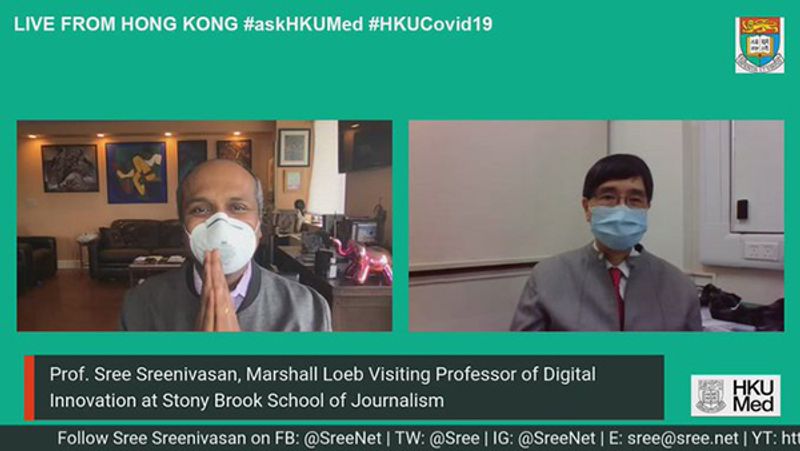Blog
Emil Guillermo: Masked in America? It's hard to wear a face mask in the U.S., but it shouldn't be

Our sabre and shield against the pandemic? Hand washing and social distancing. Keep at it. Wash up and have a Zoom meeting.
But since the curve has not flattened, and we don’t really know how many are infected (not until we test nearly everyone), we may be at the point for another tool in the U.S.: mask wearing.
Not like masquerade ball masks. More therapeutic than that. (But if you’re having a hard time with masks, go ahead and think about Kubrick’s “Eyes Wide Shut.”)
Of course, we have a problem with masks in America.
Even as an ABA (Asian born in America), I don’t relate so easily. Masks? Batman has one. So do bank robbers. And the Klan.
In America, we like transparency. As Missourians say, “Show me.” Everyone else says, we want to see your face.
For some reason, that’s in the American DNA. We don’t trust what’s hidden. Unless it’s the terms of service for a new app or software. Who reads that? In technology we trust, blindly.
Everything else, it’s show me. In big letters.
The mask calculation is even more culturally complicated when we ask, who else wears masks in public, besides superheroes?
Asians in Asia, of course, and recent Asian immigrants who live in densely populated areas. Among Asian Americans, the mask is no big deal, commonplace and often necessary.
In places like Hong Kong, Beijing, and Tokyo–where social distance often requires a new zip code–masks are the accepted norm. At first glance, it might look like mask wearers want to protect themselves.
But really, it’s done more out of concern for you, or anyone else in tight quarters, who may be within six feet.
“It’s a matter of respect,” said a woman I call “Akira,” to protect her privacy.
When Trump’s “Chinese Virus” talk infected America, Akira found herself attacked by someone she described as a “white construction worker-type in his 40s,” who saw Akira’s mask as the target on her face.
He was reacting to his notion of Asian stereotypes and his own xenophobia. The man rushed Akira, a Japanese American, like it was football practice, and pushed her to the ground.
Akira broke her finger, but mostly, she was in shock. She’s just one of more than 1,000 cases that have been reported to a website collecting data of violent incidents against Asian Americans in the last ten days of the pandemic. Researchers tell me the list grows by 100 cases each day.
Akira, born in Japan, a New Yorker for nearly 30 years, is recovering now. She’s become a statistic—an Asian American attacked during the pandemic. But she doesn’t believe she’s the day’s most important stat—a person infected by the virus.
Still, she told me today that she continues to wear the mask in public out of respect for others.
“Here in the U.S, nobody respects others. They are all for themselves,” she told me. “That is a problem.”
MASKED AMERICANS
So the one way to get all Americans to start wearing masks? Tell them it’s about selfishly saving themselves.
Asians see it more as a sign of being a good citizen, sick or not, keeping their droplets to themselves, so as not to infect anyone else.
Americans, like the one who attacked Akira, see being forced to wear a mask like being forced to wear seat belts. It’s an affront to liberty.
It may also be seen as a debilitating symbol of someone weak or ill. America the sick. Not for the brave, proud, mask-less Americans!
But now officials in the most Asian places in America, like Los Angeles and Honolulu, have called for mask wearing as a public health matter.
If the CDC and Donald Trump say yes to masks, even simple cloth ones, we’ll have to see how the majority of Americans adjusts.
“It’s going to take education and communication” said Prof. Yuen Kwok-Yung, a microbiologist, physician and Chair of Infectious Diseases at Hong Kong University.
Prof. Yung should know. He made his mark fighting SARS in the 2000s, and just published a piece this week in the International Journal of Epidemiology, defending mask wearing. Appearing on Sree Sreenivasan’s daily Covid-19 periscope broadcast, Prof. Yung called wearing a mask a “social duty” that could help cut the spread of the virus. But he said in America, it may require training, perhaps even some persuasive advertising, before forcing Americans by some “draconian measure” to wear masks.

Americans want to do things by choice, but there’s no constitutional right to go mask free.
Yung said the science definitely justifies the mask. He said we know that asymptomatic people can spread the disease unknowingly through their saliva, through microscopic droplets big and small in their breath. They infect the air, surfaces, and other people around them. A mask would prevent all that and protect others.
Mind you, we’re not talking about the heavy duty N-95 masks–the ones that must go to the nurses and docs on the front lines–but cloth or regular surgical masks. Critics do warn about masks giving a false sense of security, since masks don’t cover the eyes or are sometimes ill-fitting.
But as the professor knows, the science isn’t masked. It’s there.
Go ahead, put it on your face. It can stop the spread. It’s not just an Asian thing.
Akira, undaunted by being attacked, was walking around with her mask today, like a good citizen and without fear.
“More people in New York are wearing them,” she said. And maybe across America soon.
Her attacker may have been irrational, but wearing a mask is not.

Emil Guillermo is an independent journalist/commentator. Updates at www.amok.com. Follow Emil on Twitter, and like his Facebook page.
The views expressed in his blog do not necessarily represent AALDEF’s views or policies.
Read Emil's full bio →